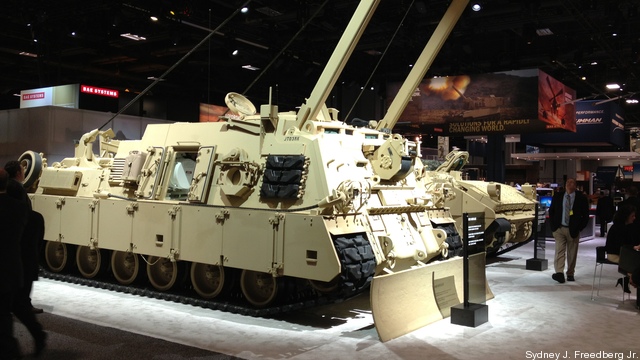 AUSA: The Association of the US Army’s annual meeting was smaller this year, but when it comes to AUSA — like most things Army-related– small is a relative term.
AUSA: The Association of the US Army’s annual meeting was smaller this year, but when it comes to AUSA — like most things Army-related– small is a relative term.
The conference, held this week, engulfed the entire Walter E. Washington Convention Center. Defense industry displays ranging from rifles to huge armored vehicles sprawled over 198,000 square feet of exhibit halls. Counted country-style, that’s four-and-a-half acres, enough for a modest farm, only packed with weaponry instead of wheat.
Some participants did downsize this year, most notably the Army itself. New restrictions on DoD attendance at conferences, inspired by the GSA and VA conference scandals, meant there were noticeably fewer folks in uniform on the floor.
“It’s unfortunate,” said Tom Captain, head of aerospace and defense analysis for Deloitte LLP, who regularly attends the conference. “One of the great things about AUSA is the celebration of the military and the [troops’] families,” he said. “There’s a trade show tacked onto it, [but] it’s not a vendor conference or a trade fair. It’s different from what you would have at the Paris Air Show.”
The one group that was noticeably more in evidence, Captain told Breaking Defense, was foreign arms companies, often grouped in national pavilions — one for France, one for Turkey, and so on. Just as US arms makers are responding to shrinking budgets by seeking sales abroad, more foreign companies are responding to cutbacks in their own countries by coming here. “I detected a higher degree of presence from French, Norwegian, Canadian, and other countries’ companies,” he said. “Foreign companies are here trying to edge in on sales of military equipment even though it’s getting smaller and smaller.”
“I would say things are a bit muted,” Captain summed up. “I think people are trying to survive — that’s the overall sentiment I picked up. ‘Life must go on.'”
AUSA’s chief spokesman put a more positive spin on things. “The vibe is still very much alive,” David Liddle told Breaking Defense. Though some companies cut back, “it’s a cost-effective way for them to reach their customer [and] for the Army to reach the public,” he said. “This is the best one-stop shop.”
Certainly, the AUSA agenda was packed with events with senior leaders, from Army Secretary John McHugh — attending despite a broken hip — to program managers for tanks, combat networks, and Humvees. As a reporter and representative of the taxpayer, there’s no other way to get access to so many senior Army leaders and grill them on the important topics of the day. As an educational and public policy venture, AUSA shines. And the exhibit halls, as always, were a sensory overload of military hardware. Below are some choice photos from the floor.
Norway’s air defense priorities: Volume first, then long-range capabilities
“We need to increase spending in simple systems that we need a huge volume of that can, basically, counter very low-tech drones that could pose a threat,” Norway’s top officer told Breaking Defense, “so we don’t end up using the most sophisticated missile systems against something that is very cheap to buy.”



























